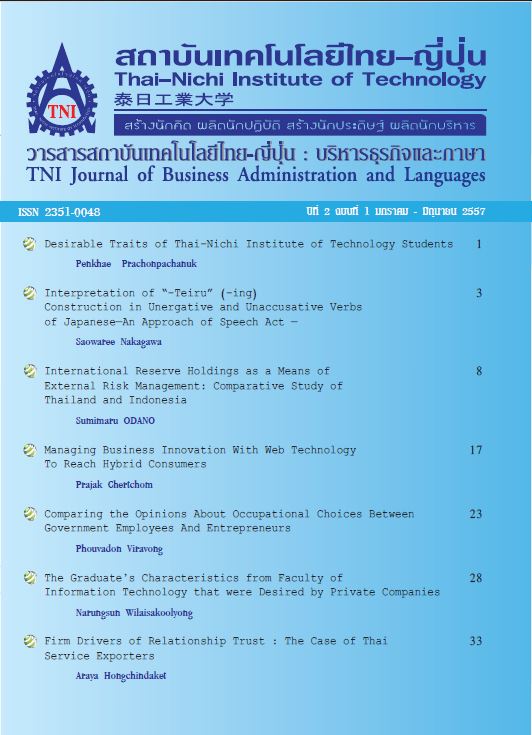International Reserve Holdings as a Means of External Risk Management: Comparative Study of Thailand and Indonesia
Main Article Content
Abstract
When one looks back over the past three decades in the Southeast Asia, it would be immediately remembered that some occasional external shocks led to cause devastating damages upon this region. One most significant case was the so-called Asian currency crisis. This shock eventually brought extremely harmful effects on those economies in 1997 and afterward. One found that this crisis created more lethargic economic situation in various Asian economies than the twice oil crises together.1 It should be noted that this crisis unexpectedly emerged. Thus those countries were not well-prepared how to deal with first of all. In those days, the Southeast Asian economies were in the midst of the comfortable economic growth stage since 1970s. Almost a decade later, the second external shock was detected in 2008. This one was the worldwide financial crisis. The crisis was triggered by the Lehman shock. It is said that the deteriorating financial environment had been brought about by the wide-spread sub-prime mess initiated by the US financial troubles. Quite interestingly, this latest shock has created less serious devastation over the region, relative to the advanced industrial countries. This second shock helps reconfirm the emerging Asian economies once more.
Article Details
Article Accepting Policy
The editorial board of Thai-Nichi Institute of Technology is pleased to receive articles from lecturers and experts in the fields of business administration, languages, engineering and technology written in Thai or English. The academic work submitted for publication must not be published in any other publication before and must not be under consideration of other journal submissions. Therefore, those interested in participating in the dissemination of work and knowledge can submit their article to the editorial board for further submission to the screening committee to consider publishing in the journal. The articles that can be published include solely research articles. Interested persons can prepare their articles by reviewing recommendations for article authors.
Copyright infringement is solely the responsibility of the author(s) of the article. Articles that have been published must be screened and reviewed for quality from qualified experts approved by the editorial board.
The text that appears within each article published in this research journal is a personal opinion of each author, nothing related to Thai-Nichi Institute of Technology, and other faculty members in the institution in any way. Responsibilities and accuracy for the content of each article are owned by each author. If there is any mistake, each author will be responsible for his/her own article(s).
The editorial board reserves the right not to bring any content, views or comments of articles in the Journal of Thai-Nichi Institute of Technology to publish before receiving permission from the authorized author(s) in writing. The published work is the copyright of the Journal of Thai-Nichi Institute of Technology.
References
Aizenman, Joshua and Nancy Marion (2003), “The demand for international reserves in the Far East: What is going on?”, Journal of Japanese and International Economy, 17, pp.370-400.
Bernanke, Ben. S. (2007), “Global Imbalances: Recent Developments and Prospects”, Speech delivered at the Bundesbank Lecture, Berlin, Germany, September 11, 2007.
Blanchard, Olivier (2000), Macroeconomics (Second Edition), Prentice-Hall, Chap. 20, pp.396-98.
Cooper, Richard N. (2007), “Understanding Global Imbalances”, Brookings Papers on Economic Activity, pp.237-261.
Edwards, Sebastian (2004), “Thirty Years of Current Account Imbalances, Current Account Reversals and Sudden Stops”, NBER Working Paper 10276.
Encarnation, Dennis J. (1992), Rivals Beyond Trade: America versus Japan in Global Competition, Cornell University Press.
Flood, Robert and Nancy Marion (2001), “Holding International Reserves in an Era of High Capital Mobility”, Brookings Trade Forum, Brookings Institution, Washington, D.C.
Goldstein, Morris (1998), The Asian Financial Crisis: Causes, Cures, and Systematic Implications, Institute for International Economics, Washington, D.C.
Johnson, Chalmers (1982), MITI and the Japanese Miracle: The Growth of Japanese Industrial Policy, 1925-1975, Stanford University Press.
Kaminsky, Graciela L., Carmen M. Reinhart, and Carlos A. Vegh (2003), “The Unholy Trinity of Financial Contagion”, NBER Working Paper 10061.
Masson, Paul (1999), “Contagion: Monsoonal Effects, Spillovers and Jumps Between Multiple Equilibria”, in The Asian Financial Crisis: Causes, Contagion and Consequences, Pierre-Richard Agenor, Marcus Miller, David Vines and Axel Weber (eds.), Cambridge University Press.
Mishkin, Frederic S. (2006), The Next Great Globalization, Princeton University Press, New Jersey.
Odano, Sumimaru (2008), “External Risk Management and International Reserve Holdings by East Asian Countries”, Hikone Ronso (Shiga University), 372, pp.99-118.
Radelet, Steven and Jffrey D. Sachs, “The East Asian Financial Crisis: Diagnosis, Remedies and Prospects”, Brookings Papers on Economic Activity, 1: pp.1-74.
Rodrik, Dani (2006), “The Social Cost of Foreign Exchange Reserves”, International Economic Journal, Vol.20, No.3, pp.253-266.
Stiglitz, Joseph E. (2002), Globalization and Its Discontents, W.W. Norton, New York.


